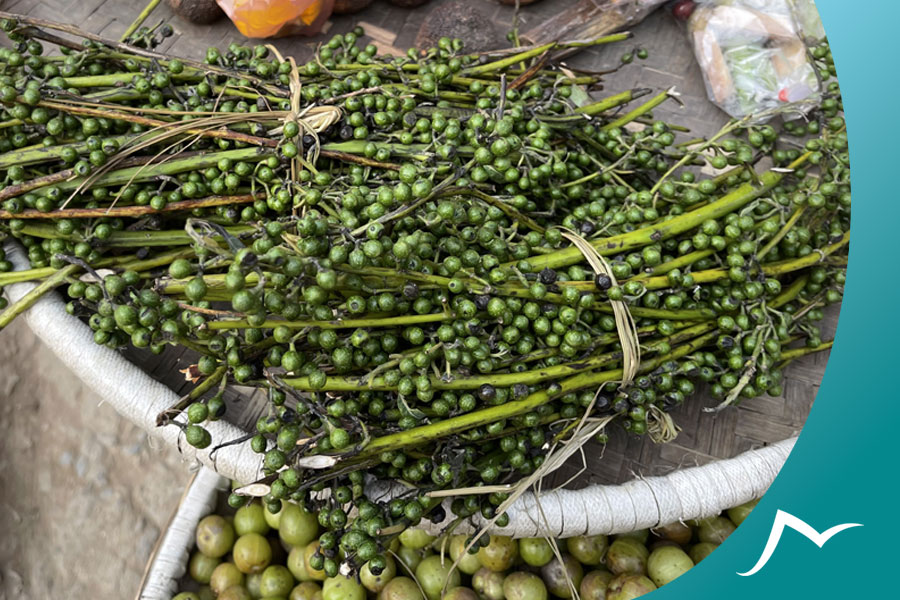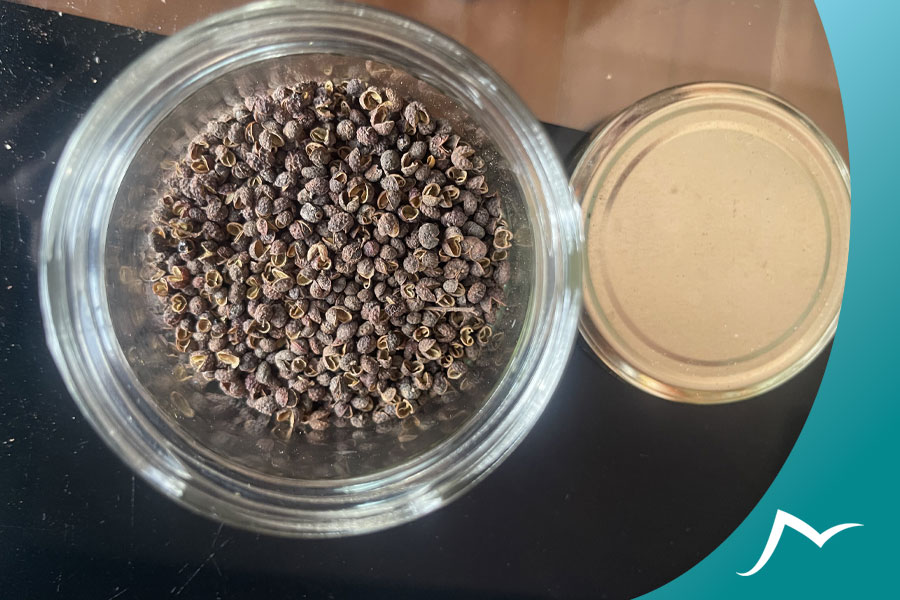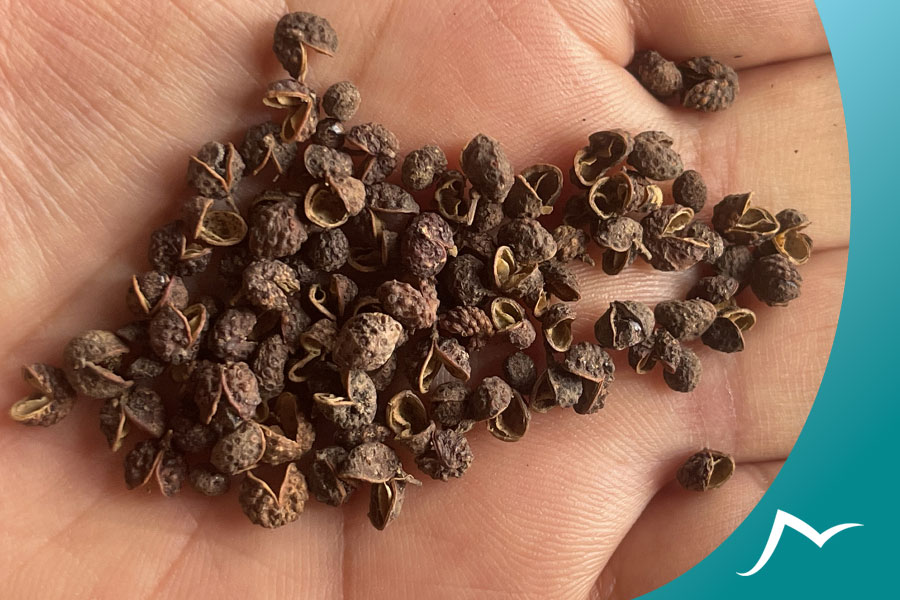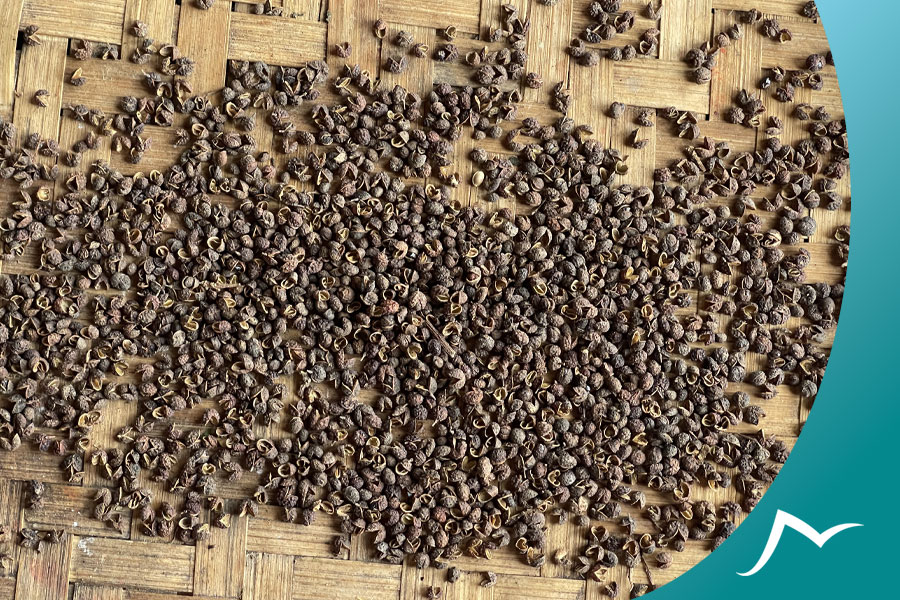As someone who grew up in a Nepalese household, I can attest to the importance of spices in our cuisine. One spice that stands out is Timmur, which has a unique flavor profile that sets it apart from other spices. As a child, I could not distinguish between timmur and black pepper by appearance. Later on, I became a fan of its unique test.
Timmur is an essential ingredient in many traditional Nepalese dishes and plays a significant role in our culinary culture. In this comprehensive guide on Timmur in Nepalese cuisine, I aim to provide an in-depth exploration of this spice and its significance in Nepalese cooking. From its definition and characteristics to its health benefits and sustainable production, I will cover everything you need to know about Timmur. So let’s dive in and discover the wonders of Timmur in Nepalese cuisine.
Timmur in Nepalese Cuisine: Definition and Characteristics
Timmur is a popular spice used in Nepalese cuisine that has gained recognition across the globe. It is also known as the ‘Nepalese pepper’ and is a species of Szechuan pepper. Timmur’s unique flavor is both citrusy and peppery, making it an essential ingredient in many traditional Nepalese dishes.
The physical appearance and characteristics of Timmur are distinct. It has small, round, reddish-brown seeds that are dried and ground into a coarse powder. The taste is mildly hot, with a slight numbing sensation, and is often compared to the flavor of black pepper.

Timmur is cultivated and harvested in Nepal, where it grows abundantly in the wild. Farmers usually harvest Timmur in late autumn, and the dried berries are then collected, processed, and packed for sale. It is a sustainable crop, as it grows without any need for pesticides or fertilizers, making it an eco-friendly choice for environmentally conscious people.
In Nepalese cuisine, Timmur is used in a variety of dishes, including curries, stews, pickles, and chutneys. It is also a popular ingredient in traditional Nepalese momos (dumplings), which are a staple dish in the country.
The Cultural Significance of Timmur in Nepalese Cuisine
Timmur is an essential ingredient in Nepalese cuisine and holds cultural significance. In traditional Nepalese dishes, Timmur adds depth and complexity to the flavors.
One of the most popular Nepalese dishes featuring Timmur is the traditional momo, which is a steamed dumpling filled with minced meat and vegetables. Timmur is added to the filling, providing a unique taste that enhances the dish’s flavor. Traditional Nepalese dishes featuring Timmur include achaar (pickle), chutneys, and curries.
Regional variations in Timmur usage are prevalent in Nepalese cuisine. For instance, in the eastern region of Nepal, Timmur is often used in pickle recipes. In the western region, it is commonly used in curries; in the central region, it is a popular ingredient in chutneys.
Timmur’s significance in Nepalese culinary culture extends beyond its use in cooking. It is also used for medicinal purposes, as it is believed to aid digestion and promote healthy respiratory function. In Nepalese festivals and ceremonies, Timmur is used as an offering to the gods, signifying its spiritual importance.
Flavor Profile and Health Benefits of Timmur in Nepalese Cuisine
Timmur has a distinct citrusy and peppery flavor with a hint of sweetness, making it a versatile spice that can be used in savory and sweet dishes.

Apart from its culinary use, Timmur also has several health benefits. It is a rich source of vitamins and minerals such as calcium, iron, and vitamin C. It also contains antioxidants that help protect the body against diseases and improve overall health.
In addition to its nutritional value, Timmur also has medicinal properties. It is used in Ayurvedic medicine to treat various ailments such as coughs, colds, and digestive problems. Its anti-inflammatory properties help in reducing inflammation and pain in the body.
One popular way of consuming Timmur for its health benefits is by making Timmur tea. This tea is made by boiling water with a few Timmur seeds and sweetening it with honey or sugar. It is believed to help with digestion and boost immunity.
In conclusion, Timmur not only adds flavor to Nepalese cuisine but also provides numerous health benefits. Its unique flavor profile and medicinal properties make it a valuable spice in traditional Nepalese dishes and Ayurvedic medicine.
Types of Timmur Used in Nepalese Cuisine
Timmur is an essential ingredient in Nepalese cuisine, and there are various types of Timmur used in the Nepalese kitchen. Each type of Timmur has a unique flavor profile, and its usage varies based on the dish being prepared.
Commonly used types of Timmur in Nepalese cuisine:
Bhanjyang Timmur
This type of Timmur is grown in high-altitude regions and has a strong, pungent flavor with a hint of citrus.
Bheda Timmur
This Timmur variety is grown in lowland regions and has a milder flavor than Bhanjyang Timmur. It is commonly used in dishes like pickles and chutneys.
Chhopre Timmur
This type of Timmur is rare and difficult to find. It has a distinct floral aroma and is used in traditional Nepalese dishes like Newari-style buff (water buffalo) choila.
Phurse Timmur
This Timmur variety is known for its spicy flavor and is used in dishes like achaar (pickle) and chutney.
Tingla Timmur
This type of Timmur has a unique smoky flavor and is commonly used in meat dishes like sukuti (dried meat) and sekuwa (grilled meat).
Availability and accessibility of Timmur in Nepalese cuisine
Timmur is widely available in Nepal, and it is not uncommon to find Timmur bushes growing in people’s backyards. In recent years, there has been an increase in the export of Timmur to other countries due to its growing popularity. However, outside of Nepal, it can be challenging to find Timmur, and it is often substituted with other spices like Szechuan pepper or black pepper. It is recommended to use Timmur whenever possible as it is a crucial component in creating the unique flavor profile of Nepalese cuisine.
Cooking with Timmur in Nepalese Cuisine
Timmur is a versatile spice that can be used in a variety of ways in Nepalese cuisine. Timmur adds depth and complexity to many traditional dishes, from its unique flavor profile to its medicinal properties. In this section, I will discuss some techniques for using Timmur in Nepalese cooking, traditional recipes that use Timmur as an ingredient, and Timmur spice blends in Nepalese cuisine.
Techniques for using Timmur in Nepalese Cooking
Timmur can be used in many ways in Nepalese cooking, depending on the dish and the desired flavor profile. Some popular techniques include toasting and grinding the seeds, infusing the whole fruit in oil or water, and using it as a finishing spice.

Toasting and grinding the seeds can bring out the earthy, citrusy flavors of Timmur and create a fine powder that can be used in spice blends or as a seasoning for meats and vegetables. Infusing the whole fruit in oil or water can extract the oils and flavors and create a unique base for soups, stews, and sauces. Using it as a finishing spice can add a subtle kick of heat and citrus to dishes such as curries, chutneys, and pickles.
Traditional Nepalese recipes that use Timmur as an ingredient
Timmur is a staple ingredient in many traditional Nepalese dishes. Some famous examples include momos (dumplings), Dal Bhat, aloo tama (potato and bamboo shoot curry), and sel roti (sweet rice doughnuts). In momos, Timmur is typically used in the meat filling to add a spicy, aromatic kick. In aloo tama, it is often used in the spice blend to create a flavorful base for the curry. And in sel roti, it is used as a finishing spice to add a hint of citrus and heat.
Timmur spice blends in Nepalese cuisine
Timmur is also a key ingredient in many Nepalese spice blends, such as the famous momo masala and jwano ko jhol. These blends typically include a mix of Timmur, cumin, coriander, and other spices and can be used as a seasoning for meats, vegetables, and grains.
Timmur in the Global Market and Nepalese Cuisine
Timmur, a staple spice in Nepalese cuisine, is gaining popularity in the global market as an exotic and unique flavor. The spice, used in Nepalese cooking for generations, is now finding its way into international kitchens and spice racks. As someone with a lot of experience cooking with Timmur, I’ve witnessed its growing popularity firsthand.
Timmur’s unique flavor profile, which combines elements of citrus, pepper, and pine, has made it a sought-after ingredient in the global market. It’s also been gaining attention for its health benefits, including anti-inflammatory and anti-bacterial properties.
As Timmur continues to gain popularity, it’s essential to understand its impact on Nepalese cuisine. While the global market presents an opportunity for Nepalese farmers and spice traders, it’s crucial to ensure that the spice is being ethically and sustainably sourced. Additionally, the increasing demand for Timmur in the global market could impact its availability and affordability in Nepal.
Despite these concerns, Timmur’s growing popularity presents an exciting opportunity to showcase Nepalese cuisine globally. As chefs and food enthusiasts continue experimenting with the unique flavors of Timmur, we can expect to see even more creative uses of spice in Nepalese and international cuisine.
Whether you’re a seasoned cook or a novice in the kitchen, I highly recommend experimenting with Timmur in your cooking. Its unique flavor profile and health benefits make it a valuable addition to any spice rack.
Pairing Timmur with Nepalese Food and Beverages
As a versatile spice, Timmur adds a unique flavor to various Nepalese dishes and beverages. Pairing Timmur with Nepalese food and drinks requires some knowledge and experimentation, but the results are usually quite satisfying. In this section, I’ll explore the basics of Timmur pairing and suggest some popular Nepalese dishes and beverages that pair well with this spice.
The basics of Timmur pairing in Nepalese cuisine
Timmur has a bold, citrusy flavor with a slightly bitter note, which makes it an ideal pairing for meat-based Nepalese dishes. It’s also a great match for lentil-based soups and stews. However, due to its strong flavor profile, it’s important to use Timmur in moderation, or it can overpower other flavors in the dish.
Timmur pairing with popular Nepalese dishes
One of the most popular Nepalese dishes that pair well with Timmur is the traditional Newari dish, choila. Choila is a spicy grilled meat dish usually made with buffalo or chicken. Timmur is one of the key ingredients in the marinade for choila, giving the word a distinctive smoky flavor.
Another Nepalese dish that pairs well with Timmur is the lentil-based soup, dal bhat. Timmur adds a citrusy kick to the soup and balances out the earthy lentil flavors. Timmur can also be added to momos, the famous Nepalese dumplings, to give them an extra zing.

Timmur pairing with Nepalese beverages
Timmur can also be used to spice up Nepalese beverages. For example, Timmur-infused honey can be added to tea or coffee to give them a unique flavor. It can also be added to cocktails to give them a spicy twist. Timmur is a critical ingredient in the famous Nepalese cocktail, the Timmur Margarita.
Common Myths about Timmur in Nepalese Cuisine
As someone who has grown up with Nepalese cuisine and has a lot of experience cooking with Timmur, I’ve encountered many misconceptions and myths about this unique spice. In this section, I will address and debunk some of the most common myths about Timmur in Nepalese cuisine.
Myth 1: Timmur is the same as Sichuan pepper.
While Timmur and Sichuan pepper share some similarities, they are not the same spice. Timmur is native to Nepal, while Sichuan pepper is from China. Timmur has a more complex flavor profile with citrus and pine notes, while Sichuan pepper is more floral and peppery.
Myth 2: Timmur is only used in meat dishes.
While Timmur is a popular spice in meat dishes like momo and sekuwa(barbeque), it is also used in vegetarian dishes like chutneys, pickles, and soups. Its unique flavor profile pairs well with various ingredients and can add a depth of flavor to any dish.
Myth 3: Timmur is too spicy for most people.
Contrary to popular belief, Timmur is not a particularly spicy spice. It has a mild heat level similar to black pepper, making it accessible to most palates. It’s important to note that the numbing sensation caused by Timmur can make it seem spicier than it is.
Myth 4: Timmur is only grown in Nepal.
While Timmur is native to Nepal, it is also grown in other parts of the world, including Bhutan and some regions of India. However, Nepalese Timmur is highly regarded for its unique flavor profile and is considered the best in the world.
By debunking these common myths and sharing some Timmur facts and trivia, I aim to inspire a deeper appreciation for this beloved spice in Nepalese cuisine.
FAQS
Can Timmur be used as a substitute for black pepper?
Yes, Timmur can be used as a substitute for black pepper, but it has a unique flavor profile that differs from black pepper.
Is Timmur spicy?
Timmur has a mild spicy flavor, but it is not overwhelmingly hot.
Can Timmur be used in sweet dishes?
Yes, Timmur can be used in sweet and savory dishes. It adds a unique flavor to desserts like ice cream and cookies.
Is Timmur healthy?
Yes, Timmur has several health benefits. It aids digestion, has anti-inflammatory properties, and is rich in antioxidants.
Can Timmur be found outside of Nepal?
Timmur is becoming more widely available in international markets, especially in the United States and Europe.
How should Timmur be stored?
Timmur should be stored in an airtight container in a cool, dark place to preserve its flavor.
Can Timmur be grown at home?
Yes, Timmur can be grown at home in a warm, humid environment with well-draining soil. However, it may take several years for the plant to produce fruit.
Conclusion
In conclusion, Timmur is a unique and significant spice in Nepalese cuisine that offers a distinct flavor profile and numerous health benefits. This versatile spice can be used in a variety of traditional Nepalese dishes, from meat and vegetable curries to pickles and chutneys. The cultivation and harvesting of Timmur is an important part of Nepal’s agricultural industry and cultural heritage.
Despite its traditional roots, Timmur is gaining popularity in international cuisine and has the potential to become a major player in the global spice market. However, it is important to preserve the cultural significance of Timmur and maintain its connection to Nepalese cuisine.
Through this article, I hope to have shed light on the unique qualities of Timmur and its essential role in Nepalese culinary culture. As someone who has grown up with this spice and has extensive experience cooking, I can attest to the depth and complexity it brings to any dish. I encourage readers to incorporate Timmur into their cooking and to appreciate its cultural significance.



